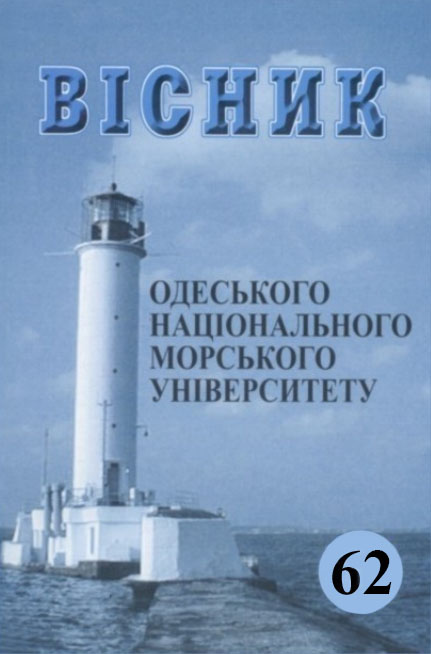Improvement of the method of calculation of strength of the pressure hull of the underwater apparatus of the toroidal form, made by winding
Main Article Content
Abstract
The problem of stress-strain state and evaluation of the strength of a hollow closed toroidal shell, which is made of a polymer composite material by winding, is investigated in the article. The method of calculating the stress-strain state and assessing the strength of hydrostatic compression of the strong body of a toroidal submarine has been improved, taking into account structural and technological factors of manufacturing by fiber winding (tape) of polymer composite materials and recommendations of the Bureau Veritas classification society on the evaluation of elastic characteristics properties of its components. Regularities of influence on the stress-strain state of the wound toroidal strong body of reinforcement schemes, geometrical parameters of the body, perspective types of reinforcing fillers and connectors, variable thickness and its averaging are obtained. It is established that failure to take into account the structural and technological factors of the method of winding and the peculiarities of the calculation of composite materials and the use of simplified calculation methods leads to a reduction of stresses twice and an error in the dangerous direction. Strength constraints are accepted in the form of a combined Tsai-Wu or Hoffman test. The evaluation of technical and economic efficiency of high-strength fibrous materials for toroidal durable housings with strength limitations in order to create rational in weight and technological terms housings depending on the depth of operation at the initial stage of device design. It is established that epoxyplastics based on medium modulus and high-strength carbon fibers are the most suitable for strong hulls of toroidal submarines.
Article Details
References
2. Sizonenko, O., Burdun, E., Prystash, S. (2018) Peculiarities of stress-strain state of toroidal pressure hull, made by winding. International journal for science, technics and innovations for the industry. Machines, Technologies, Materials, Year ХII Issue 6, рр. 240-243.
3. Sizonenko, O., Burdun, E., Prystash, S. (2018) Peculiarities of stress-strain state of toroidal pressure hull, made by spiral win-ding. International journal for science, technics and innova- tions for the industry. Machines, Technologies, Materials, PRINT ISSN 1313-0226, ISSN WEB 1314-507X, Year ХII, Issue 11, рр. 466-469.
4. Prystash, S.F., Burdun, Ye.T. (2017.) Metod rozrakhunku mitsnoho korpusu pidvodnoho aparatu v formi toru, vykonanoho namotuvanniam. Visnyk Odeskoho natsionalnoho morskoho universytetu. Odesa, № 4 (53). pp. 152-163. (in Russian).
5. Hrebeniuk, S.N., Sysoev, Yu.A., Sysoev, Yu.N (2010) Napriazhen- no-deformyrovannoe sostoianye toroydalnыkh obolochek. Visnyk Zaporizkoho natsionalnoho universytetu, № 2. Р. 24-28. (in Russian).
6. Ambarcumjan, S.A. (1974) Obshhaja teorija anizotropnyh obolo-chek / S.A. Ambarcumjan. Moskva: NAUKA, 448 p. (in Russian).
7. Bureau Veritas: Hull in Composite Materials and Plywood, Mate-rial Approval, Design Principles, Construction and Survey. March 2012 / Rule Note NR 546 DT R00 E http://www. veristar. com/ portal/veristarinfo/detail?content-id=/repository/collaboration/ sites%20content/live/veristarinfo/vi-content-avigation/genera-linfo/ giRulesRegulations/bvRules/yachtsrules).
8. Burdun, Y.T. Kreptiuk, A.V. (2014) Rational designing of compo-site toroidal pressure hull for ocean engineering. Vestnyk Astrakhanskoho hosudarstvennoho tekhnycheskoho unyversyteta. Seryia: Morskaia tekhnyka y tekhnolohyia. Astrakhan: AHTU. № 2. Р. 27-36. (in Russian).
9. Korn, G. Korn, T. (1968) Spravochnik po matematike dlja nauchnyh rabotnikov i inzhenerov. M.: Nauka, 720 p. (in Russian).
10. Grekov, V.M., Druzhilovskij, B.V., Rjabov, V.M. (2010) Ocenka tehniko-jekonomicheskoj jeffektivnosti primenenija vysokprochnyh materialov dlja korpusov podvodnoj tehniki. Trudy CNII im. akad. A.N. Krylova. Sankt-Peterburg: CNII im. akad. Krylova, № 56 (340). Р. 187-194. (in Russian).
